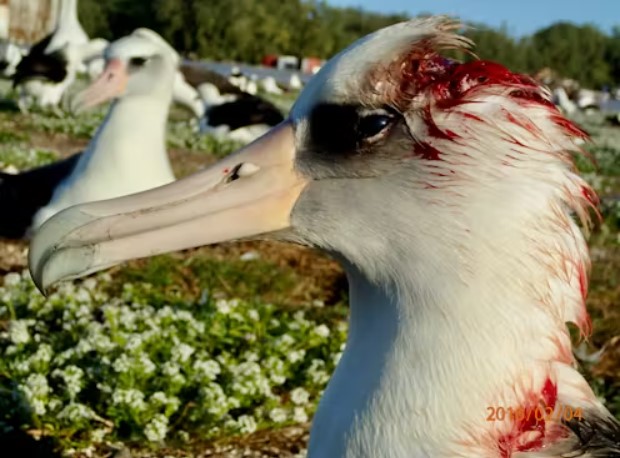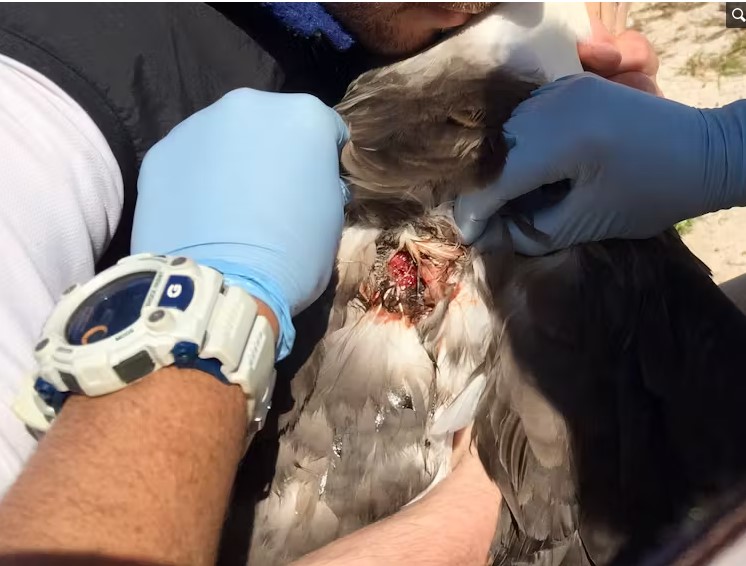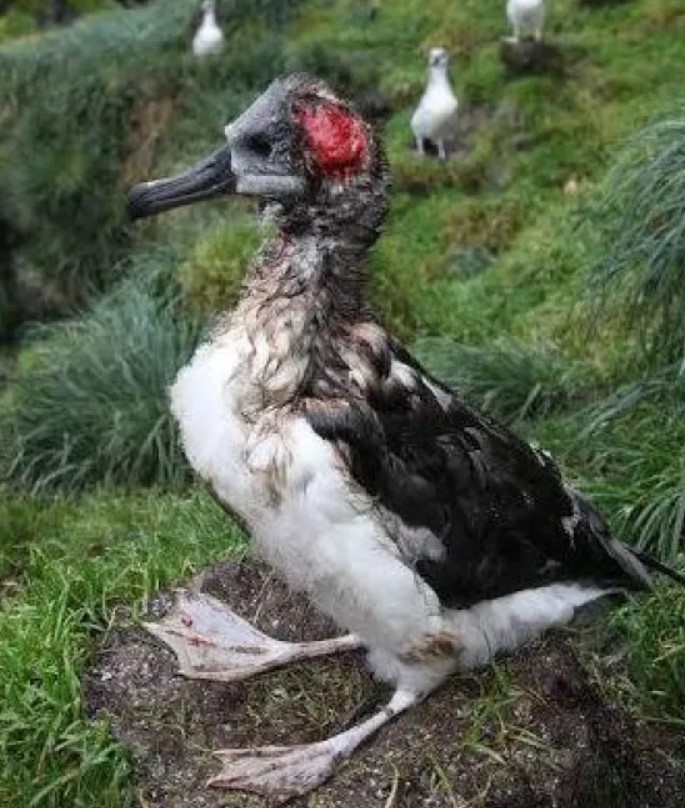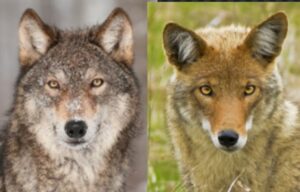ALBATROSSES EATEN ALIVE BY MICE

Their ‘island naïveté’ means these seabirds are easy pickings when mice attack. USFWS - Pacific Region/Flickr, CC BY-NC
By WIETEKE HOLTHUIJZEN
Ph.D. Ecology Candidate, Evolutionary Biology
University of Tennessee
At the far end of the Northwestern Hawaiian Islands lies Kuaihelani – also known as Midway Atoll – a small set of islands home to the world’s largest albatross colony. Over a million albatrosses return to Kuaihelani each year to breed. These seemingly pristine islands appear safe, but there’s a predator lurking among the seabirds.
House mice (Mus musculus) — the same kind that may be in your residence — have started to attack and kill albatrosses, eating them alive as they sit on their nests. I’m an ecologist who’s been studying the mystery behind these murderous mice.
A predator hiding in plain sight
Once the site of intense warfare during World War II, Kuaihelani is now a national wildlife refuge.
Without predators such as cats, rats or mongooses, Kuaihelani provides a safe haven for millions of nesting and migratory birds, including mōlī (Phoebastria immutabilis), also known as Laysan albatrosses. These seabirds, each about the size of a goose, nest in nearly the exact same spot each year, producing only one egg annually.

USFWS – Pacific Region/Flickr, CC BY-NC
In the winter nesting season of 2015, bird-counting volunteers and biologists began seeing gruesome bloody wounds on nesting mōlī. At first, they found only a few mōlī with these mysterious injuries, which included severe chewing along the neck and even scalping. In the weeks that followed, they found dozens of injured mōlī, then hundreds.
Biologists were stumped. Had a black rat escaped off a docked boat? Had a peregrine falcon blown in with the latest winter storm? Desperate to identify the culprit, biologists set up game cameras around nesting mōlī.
The cameras captured bizarre nighttime footage of mice crawling and chewing on the backs and heads of mōlī. It was the first time a house mouse had ever been observed attacking a live adult, nesting albatross.
Mōlī, like many seabirds, have evolved without predators on remote islands. As a result, such seabirds are often oddly unafraid and curious – pulling on researchers’ shoelaces or nibbling at our clipboards. This phenomenon is called “island naïveté” and, however charming, can spell disaster when nonnative predators such as rats and cats are introduced to islands. Lacking innate caution, even the largest seabirds can become the defenseless prey of predators as small as a mouse.

more facilities on Sand Island, across the channel. U.S. Navy/Wikimedia Commons
Developing a taste for flesh
During World War II, the islands of Kuaihelani were cleared and covered with wartime infrastructure. Both black rats and house mice were inadvertently introduced at this time. Soon, the rats began decimating populations of burrowing seabirds.
When the military importance of Kuaihelani faded in the 1990s, management of the atoll was transferred to the U.S. Fish and Wildlife Service. Rats were successfully eradicated in 1996, but mice remained. Thought to be small and harmless, they didn’t generate much concern until 2015.
Although scientists may never know exactly why mice began to attack and kill mōlī, we have some ideas.
Due to climate change, Kuaihelani has experienced increasingly erratic precipitation, sometimes resulting in long dry spells or intense downpours. During dry periods, vegetation quickly dies back. It’s likely the usual food items for mice, namely seeds and bugs, decline during these periods. In order to survive, mice need to find a different food source.

On an island with millions of birds, seabird carcasses are plentiful and attract a rich community of bugs, including cockroaches, isopods and maggots. Mice appear to have quite an appetite for these critters and likely feed on seabird carcasses at the same time. The transition from scavenging dead seabirds to attacking live ones that don’t fight back is only a small step.
As mouse attacks on nesting mōlī escalated from 2015 on, it was clear something needed to be done – and fast. The solution was to get rid of the mice, which, unfortunately, is much easier said than done.
Die-hard mice
Mouse eradication is a challenging and risky conservation endeavor that requires years of research and careful planning. Ideally, rodenticide, a type of poison used to kill rodents, should be offered when mice are most hungry and likely to eat it. This requires knowing exactly what they are eating and when those food sources are scarce.
By extracting and sequencing DNA from mouse poop and analyzing stable isotopes – a technique that identifies unique chemical fingerprints of organisms – my colleagues and I could figure out what organisms mice were eating and in what quantities. We found that mice on Sand Island of Kuaihelani mainly eat bugs (about 62% of their diet), followed by plants (27%) and finally albatross (likely mōlī, about 12%). The Fish and Wildlife Service identified July as the best time for the eradication attempt, since seabird density is typically lowest then.
Because of COVID-19 disruptions, the eradication attempt was delayed until July 2023, when the nonprofit organization Island Conservation and the Fish and Wildlife Service meticulously applied rodenticide in multiple rounds. At first, it seemed to be working. But in the weeks that followed, a few mice were spotted – then more. By September 2023, the eradication was declared unsuccessful.
Some conservation practitioners believe eradication should be attempted again, but others worry about creating mice resistant to rodenticide. When generations of rodents are exposed to rodenticide repeatedly, they may start to carry genetic mutations resulting in resistance to the poison, making future eradication efforts ineffective.
Without a doubt, mice on Kuaihelani have already been exposed to rodenticide for a long time. When Kuaihelani – or Midway Atoll – was a naval base, rodenticide was likely applied in and around buildings and residences. The rat eradication in 1996 was another exposure. I’m currently researching whether the mice on Kuaihelani already have these genetic mutations.
The worries about rodenticide-resistant mice aren’t limited to Kuaihelani. Around the world, especially in Europe, there are more and more cases of rodents carrying resistance. Rodents continue to have severe and widespread ecological effects on islands worldwide.
For now, I’m focused on helping the mōlī of Kuaihelani survive. But our research may also help inform the growing challenge of resistant mice around the world.





 Afrikaans
Afrikaans Albanian
Albanian Amharic
Amharic Arabic
Arabic Armenian
Armenian Azerbaijani
Azerbaijani Basque
Basque Belarusian
Belarusian Bengali
Bengali Bosnian
Bosnian Bulgarian
Bulgarian Catalan
Catalan Cebuano
Cebuano Chinese (Simplified)
Chinese (Simplified) Chinese (Traditional)
Chinese (Traditional) Corsican
Corsican Croatian
Croatian Czech
Czech Danish
Danish Dutch
Dutch Esperanto
Esperanto Estonian
Estonian Filipino
Filipino Finnish
Finnish French
French Frisian
Frisian Galician
Galician Georgian
Georgian German
German Greek
Greek Gujarati
Gujarati Haitian Creole
Haitian Creole Hausa
Hausa Hawaiian
Hawaiian Hebrew
Hebrew Hindi
Hindi Hmong
Hmong Hungarian
Hungarian Icelandic
Icelandic Indonesian
Indonesian Irish
Irish Italian
Italian Japanese
Japanese Javanese
Javanese Kannada
Kannada Kazakh
Kazakh Khmer
Khmer Korean
Korean Kyrgyz
Kyrgyz Lao
Lao Latin
Latin Latvian
Latvian Lithuanian
Lithuanian Luxembourgish
Luxembourgish Macedonian
Macedonian Malagasy
Malagasy Malay
Malay Malayalam
Malayalam Maltese
Maltese Maori
Maori Marathi
Marathi Mongolian
Mongolian Myanmar (Burmese)
Myanmar (Burmese) Nepali
Nepali Norwegian
Norwegian Pashto
Pashto Persian
Persian Polish
Polish Portuguese
Portuguese Punjabi
Punjabi Romanian
Romanian Russian
Russian Samoan
Samoan Scottish Gaelic
Scottish Gaelic Serbian
Serbian Sesotho
Sesotho Shona
Shona Sindhi
Sindhi Sinhala
Sinhala Slovak
Slovak Slovenian
Slovenian Somali
Somali Spanish
Spanish Sundanese
Sundanese Swahili
Swahili Swedish
Swedish Tajik
Tajik Tamil
Tamil Telugu
Telugu Thai
Thai Turkish
Turkish Ukrainian
Ukrainian Urdu
Urdu Uzbek
Uzbek Vietnamese
Vietnamese Welsh
Welsh Yiddish
Yiddish Yoruba
Yoruba Zulu
Zulu